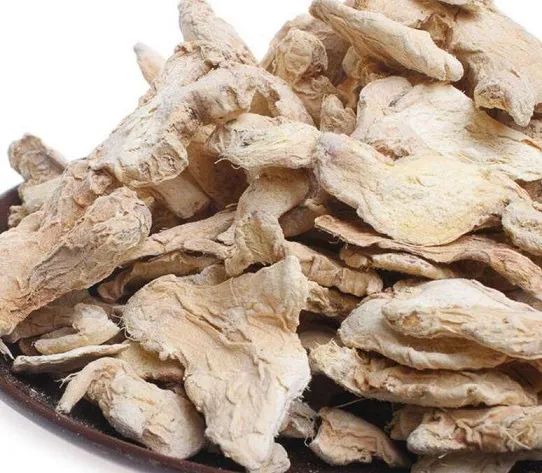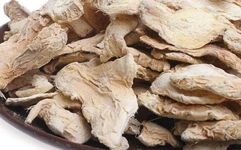Dried ginger (Gan Jiang) is made by slicing fresh ginger and then drying it through sun exposure or baking. Compared to fresh ginger, dried ginger has a more intense spiciness and a more pronounced warming effect. It is commonly used as a seasoning and can also be used medicinally, with a wide range of therapeutic effects. It is pungent in flavor and warm in nature, entering the Spleen (Pi), Stomach (Wei), Heart (Xin), and Lung (Fei) meridians. It warms the middle, disperses cold, revives yang, opens the meridians, dries dampness, resolves phlegm, and warms the lungs to transform fluids. It is indicated for cold pain in the abdomen, vomiting, diarrhea, chronic cough due to lung cold, and excessive clear phlegm. Let’s explore the effects and uses of dried ginger and the proper ways to consume it!

Effects and Uses of Dried Ginger
1. Delays Aging
Dried ginger contains rich vitamin C and gingerol, which are antioxidants that can eliminate harmful free radicals in the body, thus delaying aging.
2. Assists with Wind-Cold Common Cold
Dried ginger contains a large amount of spicy components such as zingiberene and gingerol, which can generate heat in the body and eliminate internal cold, assisting with wind-cold common colds.
3. Prevents and Treats Gastroenteritis
Certain components in dried ginger have antibacterial properties and can drive away cold and keep warm. Dried ginger enters the Spleen and Stomach meridians, making it a food that protects and strengthens the stomach, thus preventing and treating gastroenteritis.
4. Whitens Skin
The rich vitamin E content in dried ginger can help the skin resist oxidation, making the skin youthful and vibrant. Additionally, the active components in dried ginger can alleviate acne issues and accelerate the skin’s self-repair ability.
5. Promotes Blood Circulation
Dried ginger contains stimulating components that can stimulate blood vessels throughout the body, accelerating blood circulation and facilitating capillary dilation.
Proper Ways to Consume Dried Ginger
Red Tea Ginger Soup
Ingredients: 5g black tea, 1g dried ginger, 20g brown sugar
Method:
1. Place black tea and dried ginger in a pot and add an appropriate amount of water, boiling for 20-30 minutes;
2. Then add an appropriate amount of brown sugar and boil for another 3-5 minutes.
Tip: First boil on high heat until boiling, then reduce to low heat.
Honey Ginger Tea
Ingredients: 100g fresh ginger, 20g chrysanthemum, 100ml honey.
Method:
1. Clean and peel the fresh ginger, slice it, and place it in a soup pot, adding water to cover the ginger slices by about 3 cm. Bring to a boil over high heat, then reduce to low heat and simmer for half an hour;
2. Once the ginger slices release their aroma and the soup turns yellow, add chrysanthemum and continue to simmer on low heat for 10 minutes until the fragrance of chrysanthemum is released. Turn off the heat and let the soup cool naturally;
3. Finally, add honey to the pot and stir well. After cooling, it becomes chrysanthemum ginger honey, which can be filtered according to your needs.
Cola Ginger Soup
Method: Pour cola into a pot, add sliced ginger, bring to a boil over high heat, then reduce to low heat and simmer for about 10 minutes, allowing the ginger flavor to infuse into the cola. Turn off the heat, and it is ready.
This has the effects of preventing cold and resolving phlegm, increasing warmth, and warming the stomach, making it especially suitable for winter and effective in preventing and treating colds, as it can dispel wind and cold.
Good
 Effects and Uses of Epimedium and Its Consumption Methods!
Effects and Uses of Epimedium and Its Consumption Methods!
Article
 Effects and Uses of Chrysanthemum and Cassia Tea!
Effects and Uses of Chrysanthemum and Cassia Tea!
Push
 Effects and Uses of Kudzu Root Tea!
Effects and Uses of Kudzu Root Tea!
Recommend
 Effects and Uses of Kudzu Soup!
Effects and Uses of Kudzu Soup!
ImageText source: From the internet, copyright belongs to the original author
If you have any questions related to health and wellness,
feel free to leave a message below!
We also welcome everyone to share your health information
so we can live happily and healthily every day.

END

